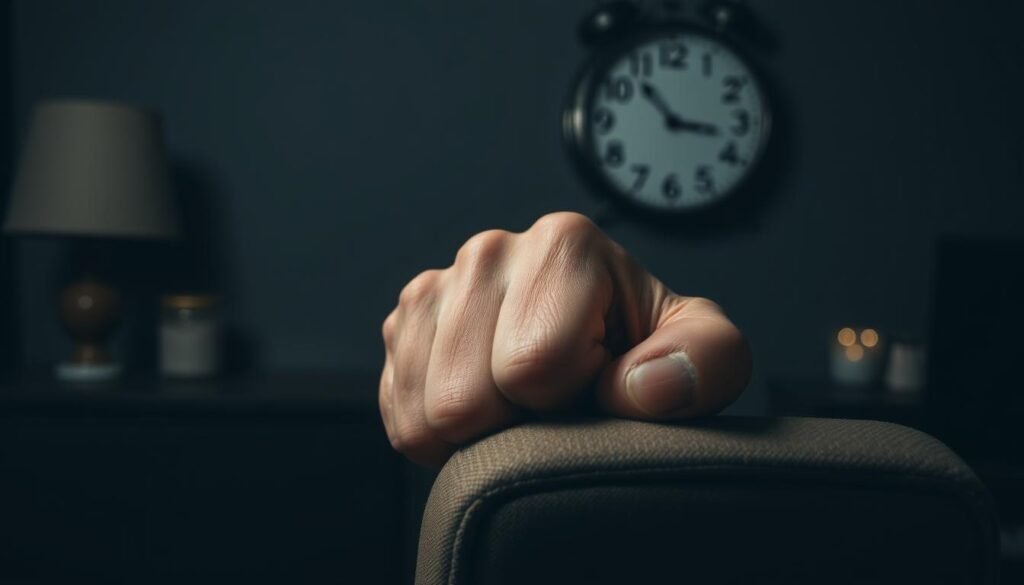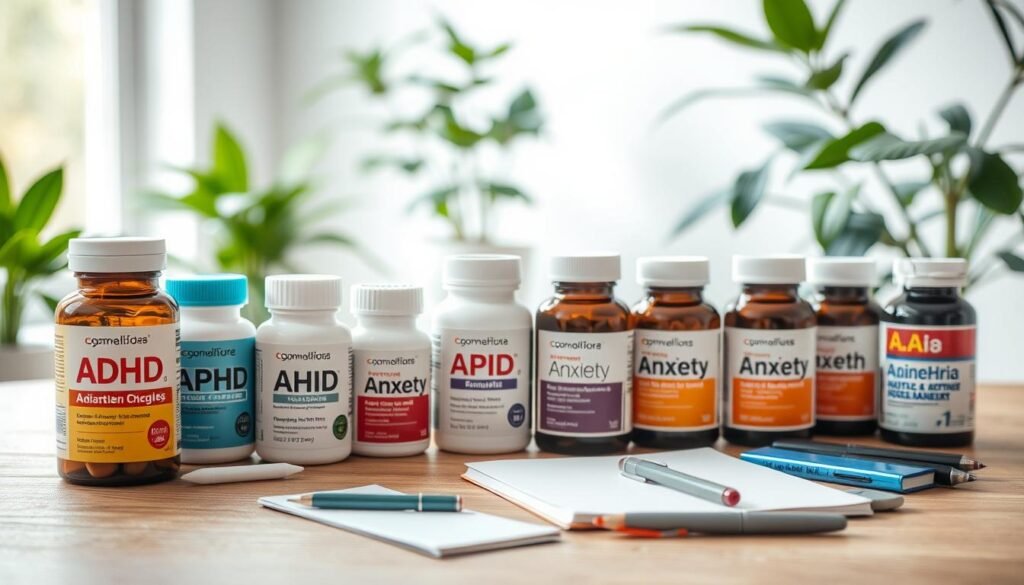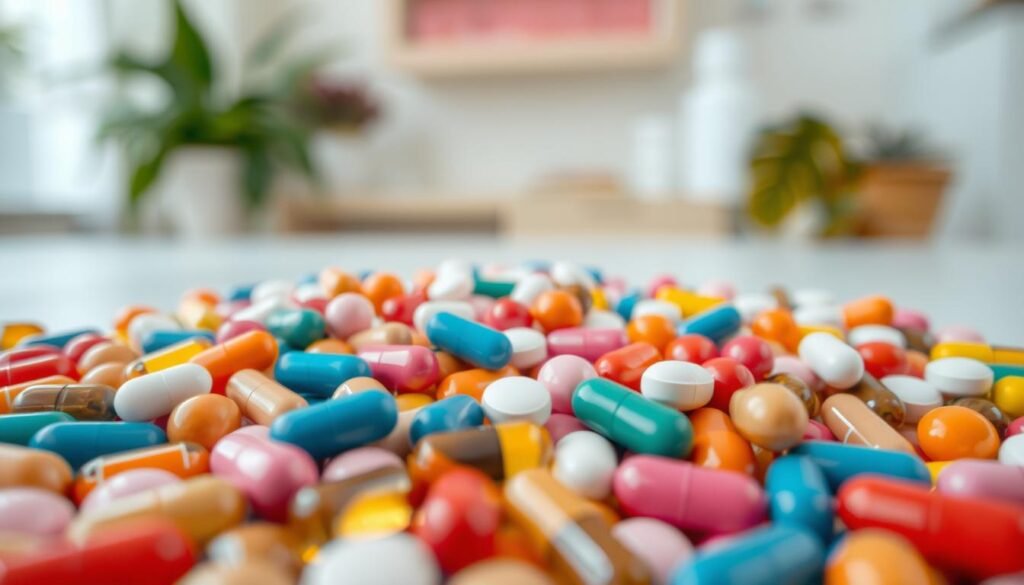It’s a surprising fact that up to 30% of adults in the United States may go through anxiety disorders at some point. For those with Attention Deficit Hyperactivity Disorder (ADHD), the situation can be even trickier. About 30-50% of them will also struggle with anxiety issues, like panic attacks or obsessive-compulsive behaviors. This overlap makes finding the right treatment complex. To really help, a mix of ADHD treatment and ADHD and anxiety medication is often needed.
Stimulants such as methylphenidate and dextroamphetamine are common choices to treat ADHD. They can help ease anxiety too. Yet, treating ADHD without a good plan might actually increase anxiety. This is a key point for those looking at mental health treatments.
There are non-stimulant options too, like atomoxetine and clonidine, for those dealing with both ADHD and anxiety. These treatments offer another route for managing these conditions. To better manage your mental health, looking into both issues at once is crucial. For deeper understanding, check out the detailed guide on ADHD and anxiety medication.
Key Takeaways
- 30-50% of individuals with ADHD may also experience anxiety disorders.
- Stimulant medications are often effective for treating both ADHD and anxiety symptoms.
- Non-stimulant drugs like atomoxetine provide alternative treatment options with fewer anxiety-related side effects.
- About 20-30% of people with ADHD may continue to struggle with symptoms despite medication.
- Genetics appears to influence the relationship between ADHD, anxiety, and other mood disorders.
- Integrative treatments, including mindfulness and therapy, can complement traditional medication strategies.
Understanding ADHD and Its Symptoms
ADHD, often seen as a childhood problem, greatly affects adults too. Many adults struggle with ADHD symptoms like hyperactivity, impulsiveness, and forgetfulness. These can disrupt everyday life and hurt personal relationships.
Adults with ADHD find it tough in areas like work, family, and socializing. They deal with issues like not paying attention, which raises stress. This can lower their quality of life. It’s crucial to fully understand ADHD for correct diagnosis and treatment. Adults show a wide range of symptoms.
Also, ADHD often comes with other conditions. Around two-thirds of people with ADHD have another disorder. A common one is anxiety, seen in nearly half of those with ADHD. Research shows mood disorders are more common in women with ADHD. This highlights the need for gender-sensitive symptom recognition. Many women get diagnosed in adulthood.
| ADHD Symptoms | Impact on Life |
|---|---|
| Hyperactivity | Disrupts work and social gatherings |
| Impulsiveness | Causes misunderstandings and conflicts |
| Restlessness | Affects concentration and productivity |
| Forgetfulness | Leads to missed deadlines and responsibilities |
Some adults face specific issues, like losing track of time and not finishing tasks. This makes daily life harder. Many feel anxiety from their ADHD symptoms, such as putting things off and fearing judgment. This shows why ADHD treatment must tackle these complex symptoms.
How ADHD and Anxiety Are Connected
The link between ADHD and anxiety is deeply significant. It touches people of various ages. About half of adults with ADHD also battle an anxiety disorder. This connection makes diagnosing and treating them more complex. Symptoms that overlap can cause incorrect diagnoses.
Anxiety can make ADHD symptoms worse, like restlessness and trouble focusing. This situation sets off a tough cycle. Unchecked ADHD symptoms can increase anxiety levels. This makes it hard for people to find the right anxiety disorder remedies. Concerns about getting things done and feeling swamped grow, adding to ADHD challenges.
Experts stress the importance of a full check-up to see if anxiety is a separate issue or part of ADHD. Knowing this helps create a personalized treatment plan. The right ADHD and anxiety medication can greatly help a person’s well-being. ADHD is usually treated with stimulants like methylphenidate or amphetamines. However, these may not be good for someone with anxiety.
For those dealing with both anxiety and ADHD, non-stimulant drugs may work better. Options include atomoxetine (Strattera) or viloxazine (Qelbree). Some also use antidepressants and specific medications for high blood pressure, like clonidine (Kapvay) and guanfacine (Intuniv, Tenex). Studies show about 30 percent of kids with ADHD also have anxiety, impacting their sleep.
A complete care plan that includes therapy, like cognitive behavioral therapy (CBT), and regular physical activity is key to managing anxiety. This well-rounded approach helps those with both conditions lead a healthier, more balanced life.
Signs of Anxiety Disorders
Anxiety disorders show up in many ways that disrupt daily life. People often feel excessive worry. This can lead to severe panic attacks. They may also have physical symptoms like a racing heart or feeling out of breath. These issues make simple tasks hard and hurt the quality of life.
About 25% of adults with generalized anxiety disorder (GAD) also have ADHD. This link shows why it’s important to recognize anxiety symptoms. Without treatment, it can make attention problems worse.
Common indicators include:
- Difficulty concentrating
- Sleep disturbances
- Feelings of chronic dread
- Increased irritability due to stress
- Tiredness resulting from mental strain

To manage anxiety, there are various strategies. This includes medication and therapy. Using stress management techniques helps too. They lessen symptoms and boost mental health. In some cases, drugs are needed when other methods don’t work well. Especially when anxiety really affects one’s daily life.
ADHD and Anxiety Medication: Treatment Options Today
Treatment for ADHD and anxiety starts with specific medicines. About half of adults with ADHD also have anxiety. This makes their treatment more complex. Adderall and Ritalin are often used first for ADHD. Zoloft, Lexapro, Effexor, and Cymbalta are common for treating anxiety.
Stimulants work well but can make anxiety worse for some. So, doctors sometimes suggest other options. Atomoxetine, Strattera, Qelbree, and Wellbutrin are alternatives for those sensitive to stimulants. Changing drugs and doses might be needed to get the right effect.
People should talk openly with their doctors about their symptoms. Following the doctor’s advice, including taking medicine as directed, is key. Regular check-ups help track the treatment’s impact and manage side effects quickly.

Combining medication with cognitive behavioral therapy (CBT) often works better. This approach helps with organizing thoughts and controlling emotions. Making a plan that fits both ADHD and anxiety is critical. It shows why personal treatment is vital. For more info, check the Cleveland Clinic’s guide on ADHD medication.
Common Stimulant Medications for ADHD
Stimulant meds are usually the first choice for ADHD treatment. Around 80% of kids with ADHD get better with these meds. They include amphetamines and methylphenidate, which boost dopamine and norepinephrine levels. These brain chemicals help improve focus and control impulses.
Effectiveness of Stimulants
Many studies show that stimulant meds work well for about 70% of people. Long-acting types help with symptoms for 8 to 24 hours. Short-acting ones start in 30 to 45 minutes and last 3 to 6 hours. They generally make a big difference in attention and behavior.
Side Effects of Stimulant Medications
Even though stimulant meds help a lot, they can have side effects. Some common ones are loss of appetite, trouble sleeping, and a faster heart rate. Rarer issues include tics and temporary tiredness or mood shifts. Doctors need to watch these effects to give the best care. For more help, many turn to support groups to share their ADHD and anxiety experiences.

Non-Stimulant Medications for ADHD
Some people with ADHD don’t do well with stimulant drugs or feel more anxious. For them, non-stimulant ADHD medications are good options. Medicines like Atomoxetine and Viloxazine focus on ADHD symptoms but have different side effects than stimulants.
Advantages of Non-Stimulant Drugs
Non-stimulant medications help in several ways. They’re great for those who can’t take stimulants or get anxious easily. Their benefits include:
- Smoother Effect: They give steady benefits without causing much agitation or sleeplessness.
- Lower Risk of Dependency: These drugs have a lower chance of addiction, making them safer for long time use.
- Effectiveness for Specific Conditions: Drugs like Clonidine and Guanfacine help with ADHD and issues like tic disorders or sleep problems.
Atomoxetine, since its FDA approval in 2003, boosts norepinephrine. This helps improve focus and control impulsivity. About half the people who try it see benefits. Viloxazine, approved in 2021, also helps, but more studies are needed to see how it compares.
Clonidine ER and Guanfacine ER are effective for both kids and adults. They help with focus and memory. They work in 55 to 60% of kids. But, they can cause sleepiness, headaches, and dizziness, so monitoring is important.
Non-stimulant ADHD drugs give doctors more options to find the best treatment for each person.
| Medication | Primary Benefit | Response Rate | Common Side Effects |
|---|---|---|---|
| Atomoxetine (Strattera) | Improves attention, reduces impulsivity | ~50% | Fatigue, stomachaches, nausea |
| Viloxazine (Qelbree) | Similar effects, newer option | Not yet established | Dry mouth, fatigue, headache |
| Clonidine ER (Kapvay) | Helps with attention and impulse control | 55-60% | Dizziness, sleepiness, dry mouth |
| Guanfacine ER (Intuniv) | Effective for ADHD and anxiety | 55-60% | Headache, fatigue, sedation |
Anti-Anxiety Medications and Their Role
Anti-anxiety drugs are crucial for people with anxiety disorders and ADHD. They include benzodiazepines and SSRIs, used by doctors to reduce anxiety. About half of adults with ADHD also struggle with anxiety.
Understanding each medication’s impact is key to effective treatment. Some drugs can help with both ADHD and anxiety. Yet, it’s vital to consider drug interactions. Stimulants like methylphenidate and amphetamines are common for ADHD but might not help anxiety.
Strattera (atomoxetine) and Intuniv (guanfacine) are non-stimulant options for those sensitive to stimulants. They are FDA-approved for ADHD. Sometimes, anticonvulsants like gabapentin are used for anxiety when other treatments don’t work.
Using medication and cognitive behavioral therapy (CBT) together can be very effective. It’s crucial to customize treatment to fit everyone’s needs.
| Medication Type | Examples | Common Uses | Considerations |
|---|---|---|---|
| Benzodiazepines | Xanax, Valium | Anxiety disorders | Risk of addiction in some individuals |
| SSRIs | Prozac, Zoloft | Anxiety, depression | Potential side effects include weight gain |
| Anticonvulsants | Gabapentin, Pregabalin | Anxiety management | Off-label use may be required |
| Non-stimulant ADHD Medications | Strattera, Intuniv | ADHD treatment | May need careful monitoring for effectiveness |
Mood Stabilizers and Other Psychotropic Medications
Mood stabilizers are key in treating mood disorders along with ADHD and anxiety. They include medications like lithium and lamotrigine. These help control mood swings and offer a more stable emotional state.
These medications also tackle depressive symptoms alongside ADHD. This ensures a well-rounded approach to treatment.
Medications such as bupropion (Wellbutrin) not only help with mood. They also boost cognitive functions. This is vital for those facing mood challenges as it helps improve their daily lives. For more info, check out resources on mood stabilizing medication.
While effective, these meds can cause side effects like sleepiness, stomach issues, and weight gain. It’s important to talk regularly with healthcare providers. They monitor side effects and adjust treatment as necessary. Understanding mood stabilizers and psychotropic medications is crucial for balanced mental health.